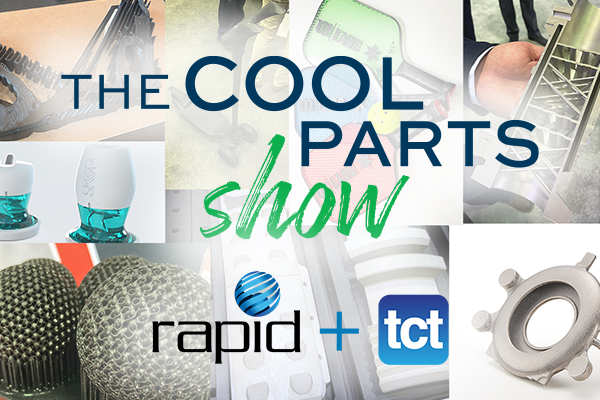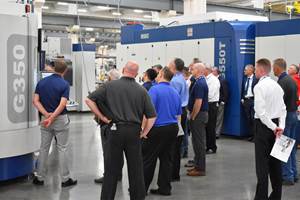The Value of a "Pathfinder Part" for Additive Manufacturing
Implementing additive manufacturing means starting somewhere. Seeking out the right pathfinder part can illustrate valuable lessons about the advantages of this technology.
Share





“If you think about the legacy platforms that our Department of Defense has across the board, when something comes out of service there’s a cost to that. There’s a cost to the taxpayer; there’s a cost to the warfighter,” says Brian Morrison. “There are so many different applications out there where additive can solve a problem to get these legacy platforms back to work.”
Morrison is director of additive manufacturing (AM) for , a position where he has led the company’s development of titanium and nickel alloys for metal 3D printing. In this role he also works closely with Rich Merlino, senior director of AM and the leader of ATI’s parts production business. Both areas of the business inform each other; the production team can call on material expertise to select powders or create new alloys when needed, while the materials team gets insight into real customer challenges and applications from the production side.
Together Morrison and Merlino have seen customers make the leap to additive, and what makes an application a good fit for AM. Ideally, they say, a company’s first step with additive manufacturing for production should be a pathfinder part — that is, a component similar to other parts in the company’s inventory such that pursuing 3D printing as a production method helps pave the way for future parts.
What makes a good pathfinder part? There are several contributing factors to take into account:
- The part solves a problem. ATI has seen that specific needs are always the best use cases for additive manufacturing. Without an urgent problem to solve, companies can spend years researching and investigating 3D printing without making any real move.
- The problem can only be solved with 3D printing. “When a customer says, ‘I have a component and it’s made this way today and it’s going fine but I want to explore additive,’ that’s not going to go anywhere,” Merlino says. But if that customer has already tried and discarded machining, casting, fabricating and any other option, additive manufacturing tends to succeed.
- The design can be flexible to the needs of both AM and finish machining. Depending on the process used, additive manufacturing may require certain changes or accommodations in the design. Material might need to be removed for instance to save time in printing, or maybe added to help with locating the part for finish machining. Some design flexibility is generally necessary to create a successful pathfinder part.
The as-printed oil collector. ATI had free rein in the design of this upgrade part, but concessions were made for the EBM process and to support finish machining. .
One last but significant note: The pathfinder part need not be a component that already exists. Brand-new parts often represent the greatest opportunity because of their complete design freedom. With no incumbent processes or tooling to contend with, additive manufacturing is free to deliver the best possible solution.
This was the case with one recent example, an oil collector that ATI created with . The piece is an upgrade for a fleet of helicopters that were suffering from oil leakage. Though the part was a new one, it proved to be a good case for metal AM and helped the customer learn how to include additive in the design philosophy going forward. Learn much more about this component .
Prefer a visual? The ATI oil collector was one of the items on display at this year’s RAPID + TCT, the largest trade show in North America devoted to 3D printing technology. The part made it into highlighting some of the most interesting 3D printed things we found on the show floor.
Related Content
Sandvik Coromant Inserts Provide Stable Turning of Aerospace Components
The new insert grades GC1205 and GC1210 cover a large application area within last-stage machining and intermediate-stage machining when turning aerospace engine components.
Read MoreGrob Systems Inc. to Host Tech Event With Industry Partners
The 5-Axis Live technology event will highlight new machining strategies for optimizing the production of complex medical, aerospace and mold/die parts.
Read MoreBroaching Tool Technology For Lathes Used to Slot Inconel Parts
This shop finds value in using an indexable-insert-style broaching tool to create blind-hole slots in heat-treated Inconel aerospace parts on a CNC lathe.
Read MoreFunction Over Form
While the metalworking industry includes a wide variety of machine shops, it is worthwhile remembering that the differences obscure a key commonality: they all run on human ingenuity.
Read MoreRead Next
AMRs Are Moving Into Manufacturing: 4 Considerations for Implementation
AMRs can provide a flexible, easy-to-use automation platform so long as manufacturers choose a suitable task and prepare their facilities.
Read MoreLast Chance! 2025 Top Shops Benchmarking Survey Still Open Through April 30
Don’t miss out! 91ÊÓƵÍøÕ¾ÎÛ's Top Shops Benchmarking Survey is still open — but not for long. This is your last chance to a receive free, customized benchmarking report that includes actionable feedback across several shopfloor and business metrics.
Read MoreMachine Shop MBA
Making Chips and 91ÊÓƵÍøÕ¾ÎÛ are teaming up for a new podcast series called Machine Shop MBA—designed to help manufacturers measure their success against the industry’s best. Through the lens of the Top Shops benchmarking program, the series explores the KPIs that set high-performing shops apart, from machine utilization and first-pass yield to employee engagement and revenue per employee.
Read More.jpg;width=70;height=70;mode=crop)























